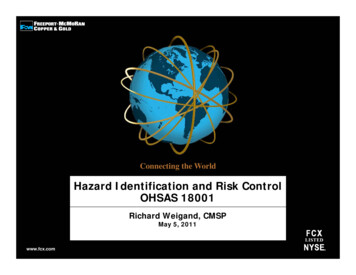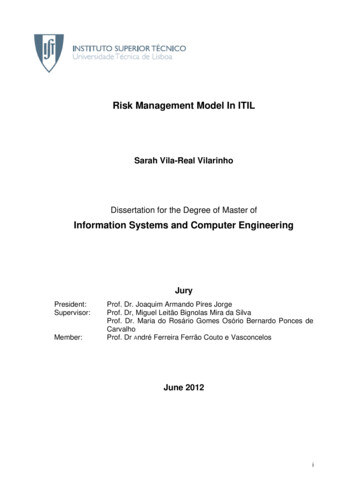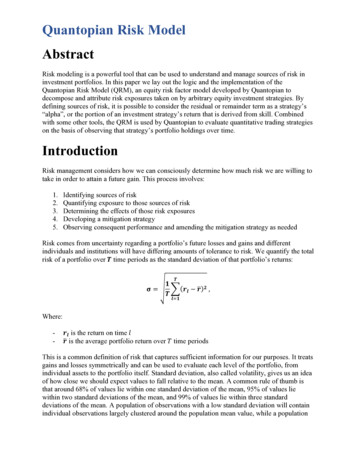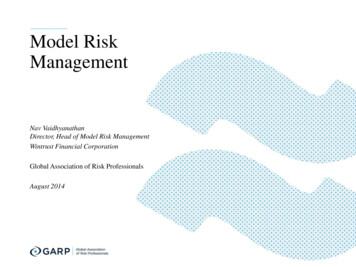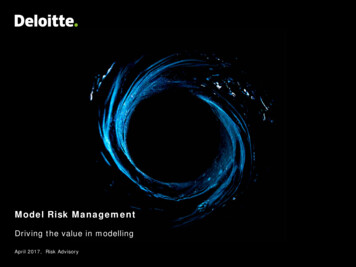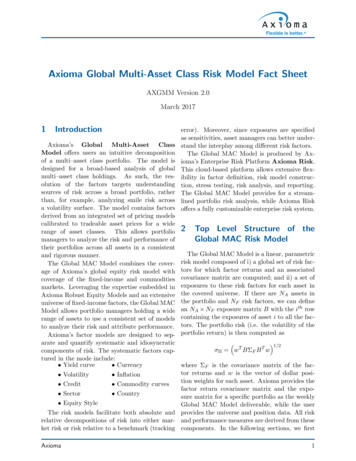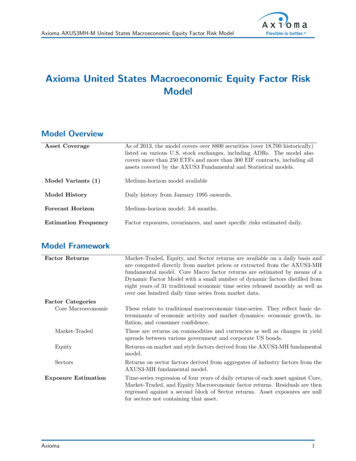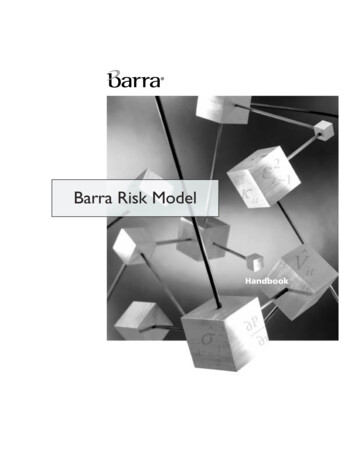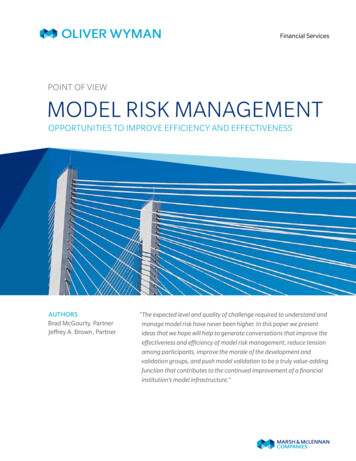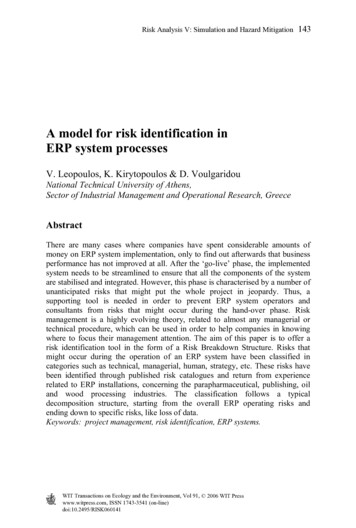
Transcription
Risk Analysis V: Simulation and Hazard Mitigation143A model for risk identification inERP system processesV. Leopoulos, K. Kirytopoulos & D. VoulgaridouNational Technical University of Athens,Sector of Industrial Management and Operational Research, GreeceAbstractThere are many cases where companies have spent considerable amounts ofmoney on ERP system implementation, only to find out afterwards that businessperformance has not improved at all. After the ‘go-live’ phase, the implementedsystem needs to be streamlined to ensure that all the components of the systemare stabilised and integrated. However, this phase is characterised by a number ofunanticipated risks that might put the whole project in jeopardy. Thus, asupporting tool is needed in order to prevent ERP system operators andconsultants from risks that might occur during the hand-over phase. Riskmanagement is a highly evolving theory, related to almost any managerial ortechnical procedure, which can be used in order to help companies in knowingwhere to focus their management attention. The aim of this paper is to offer arisk identification tool in the form of a Risk Breakdown Structure. Risks thatmight occur during the operation of an ERP system have been classified incategories such as technical, managerial, human, strategy, etc. These risks havebeen identified through published risk catalogues and return from experiencerelated to ERP installations, concerning the parapharmaceutical, publishing, oiland wood processing industries. The classification follows a typicaldecomposition structure, starting from the overall ERP operating risks andending down to specific risks, like loss of data.Keywords: project management, risk identification, ERP systems.WIT Transactions on Ecology and the Environment, Vol 91, 2006 WIT Presswww.witpress.com, ISSN 1743-3541 (on-line)doi:10.2495/RISK060141
144 Risk Analysis V: Simulation and Hazard Mitigation1Introduction1.1 The project of ERP implementation (hand-over phase)In the early 90’s, increased complexity of business and the need to integrate allthe functions within an enterprise to sustain in the dynamic environment led tothe development of the ERP systems, which are packaged (though customisable)software applications, which manage data from various organisational functionsand provide a fully integrated solution to major organisational data managementproblems. These systems offer the advantage of providing organisations with asingle, integrated software system linking the core business activities such asoperations, manufacturing, sales, accounting, supply chain transactions andinventory control.The projects of ERP implementations are always large and complex.Although the Product Breakdown Structure (PBS) is given, according to themodules of the software to install, the Work Breakdown Structure (WBS) iscomplicated as lags and leads complicate the precedence of the activities.Important milestones have to be met, mainly when the integration of the differentmodules takes place. In addition this type of projects are executed bycomplicated matrix structures as the project team will include, at least for a partof the duration of the project, employees of all the departments of the company.The project office has to coordinate the project team under considerable timepressure and facing many unforeseen events [1]. However, simply setting up anERP solution is not enough. It is common for companies to face ERPs as projectswith the assumption that the day the system will go-live the project will end. Thetruth is that an enterprise system installation will not end as a typical project butthe system needs to be constantly supported and optimised. As ERP systems gothrough several stages of development and maturity, they require a lot of effortin order to achieve significant results and improve companies’ performance.There are three, core, distinct phases in ERP implementation projects, whichare the feasibility study phase (go/ no go), the installation phase (Kick off –design – go live) and the hand-over phase. This last phase, which is the projectphase between the “go-live” point and “cut-off”, the point where the consultingcompany stops offering its services as a part of the project’s contract and beginsa maintenance contract, is often underestimated as far as the duration and theresources is concerned. During this phase implementers face particular problemsas the company aligns the previous business processes with the processesimposed by the ERPs. This is the project phase where this paper is focusing on.After the ‘go-live’ phase the implemented system needs to be streamlined toensure that all the components of the system are stabilised and integrated. At thisstage company’s attention should focus on the redefinition of user roles andresponsibilities, establishment of new policies to support the ERP infrastructure,integration and utilisation of the information generated from the new system.However, the hand-over phase is most of the time ill-defined. Project plansdescribe it as a single phase, where all other phases are analysed in manycorrelated activities. This is not only a “signal” indicating that the phase isWIT Transactions on Ecology and the Environment, Vol 91, 2006 WIT Presswww.witpress.com, ISSN 1743-3541 (on-line)
Risk Analysis V: Simulation and Hazard Mitigation145mistakenly taken for an easy task but also that the activities which have to takeplace during this phase are difficult to model using the traditional activitynetworks, included in the project management tools. Thus, project managersshould pay particular attention to this phase. This paper argues that critical risksof the ERP installation projects can arise exactly in this phase and put the wholeendeavour in jeopardy. The RBS - checklist is proposed here both to identify therelative risks and as a project management tool.1.2 Risk Management (RM)Risk management is not a new field of science [2]. The first approach of theformal introduction of RM techniques in the scientific community was the effortput by Hammer [3] to apply it on technical solutions. There exists also extendedbibliography of RM in the theory of investments and financial risk field [4].Recent trends have involved RM in the project management sector [5]. However,there is no literature considering the risk management as a tool embedded in thehand-over phase of ERP implementations. This is what the authors are ambitiousto achieve through this paper.The steps of Risk Management can be summarised as in Fig. 1 [6].The first step of the process is the Development of a Risk Management Plan.This Plan sets the base for the other Risk Management steps. The second step ofthe process is the identification of risks that might affect the project.Identification is an important step of the process since one cannot cope withproblems that have not been identified. There are many techniques indicating theway to identify risks, such as checklists, experts’ interviews, etc [7]. The thirdand fourth steps of the process address the analysis issue. Depending on theamount of information available or desirable, analysis could be either qualitativeor quantitative. Next step for RM is the Mitigation Action Plan, i.e. the definitionof specific and effective response, in order to smooth or completely eliminate therisk. Preventive or corrective actions can be taken in order to obtain theminimisation of risk [6]. The last step, which is the Follow Up and Control ofrisks, aims to assure that the outcome from the previous steps is still valid as thetime goes by, the mitigation actions defined are really efficient and that everynew risk is registered.IdentificationRisk Mgt PlanQualitativeAnalysisFollow upQuantitativeMitigationFigure 1:Risk management steps.WIT Transactions on Ecology and the Environment, Vol 91, 2006 WIT Presswww.witpress.com, ISSN 1743-3541 (on-line)
146 Risk Analysis V: Simulation and Hazard MitigationThe method presented in this paper is focusing on the Risk BreakdownStructure (RBS), which is a tool for risk identification. The RBS is a simple wayof describing the structure of project risk. Risk categories can be structured in asimilar way to the Work Breakdown Structure (WBS) and shape the RiskBreakdown Structure. Following the pattern of the WBS definition by PMI, theRBS is defined as “A source oriented grouping of project risks that organises anddefines the total risk exposure of the project. Each descending level represents anincreasingly detailed definition of sources of risk to the project” [8]. The RBScan function as a base for the identification (organised identification by focusingin specific risk categories) and the creation of a list of risks using the lowerlevels of the RBS and searching for risks in each risk category (i.e. technical,financial, etc). Table 1 presents basic considerations for the method.Table 1:Advantages and disadvantages of the RBS.AdvantagesStructured presentation of risksNew risks may be identified focusingon the RBS risk categoriesThe decomposing and detailed natureof the RBS minimize the possibilityof losing risk categories or classesDirect links between risks visibleImagination not limited by fixed risklistDisadvantagesTime consuming processRisk that apply in more than oneclasses may cause data redundancies1.3 Scope and objectivesAim of this paper is to produce a structured referential of risks, including allthose risks that appear during the hand-over phase of an ERP project and affectbusiness processes, jeopardizing their alignment with the processes imposed bythe ERPs. The referential aims to assist project managers in knowing where tofocus risk management attention. The findings of this paper were derivedthrough the study of four different hand-over cases, from the publishing, the oil,the wood processing and the parapharmaceutical industrial sectors. Althoughevery ERP system is unique, the hand-over risks apply to each company studiedand fall into the majority of the categories presented in this research.The rest of this paper is organised as follows: section 2 describes the researchmethod. Section 3 is divided into two subsections. The first one presents theparapharmaceutical case study and the second encompasses the most often methand-over risks and maps them in an RBS. Finally, section 5 draws someconclusions and reveals opportunities for further research.WIT Transactions on Ecology and the Environment, Vol 91, 2006 WIT Presswww.witpress.com, ISSN 1743-3541 (on-line)
Risk Analysis V: Simulation and Hazard Mitigation2147Research methodRegarding the identification of risks, an extensive research on public riskcatalogues has been conducted. Additional risks resulted from studying the handover phase of ERP projects in four Greek industries, from the publishing, the oil,the wood processing and the parapharmaceutical industrial sectors. Risks,identified in each case, were documented in the form of risk sheets. Theliterature review followed a top down approach concerning the categorisation ofrisk, while the risks identified during the case studies followed a bottom upapproach. These two approaches (literature review and practical experience)were merged in order to provide a complete risk referential. Although, thecompanies have implemented ERP systems from different vendors, thecomparison led to the conclusion that the risks of the hand-over phase can be metin various companies with different systems and different corporate cultures.The outcome of the research is an RBS tool, which is considered to be crucialfor future ERP implementations.The next section is divided into two subsections. The case study of theparapharmaceutical industry is presented in the first one, while the secondencompasses the findings of the literature review and the four case studies.3Case study and findings3.1 The parapharmaceutical industryThe (para)pharmaceutical industry’s supply chain consists of four majorplayers [4]:1. Suppliers of raw materials2. (Para)pharmaceutical production companies3. Wholesalers, who act as links between a production company and a point ofsales (either a pharmacy or a brand pharmacy).4. Stores that are allowed by legislation to sell drugs (pharmacies and brandpharmacies). Individual pharmacies are small and very small enterprisesowned by pharmacists, while brand pharmacies are unions formed by severalindependent pharmacies under the same brand. Pharmacies and brandpharmacies have the possibility to buy either from a wholesaler or the mainvendor who is the production company. Although independent pharmacies canbuy from any vendor, they often develop exclusive supplier – customerrelationships. Conventionally transactions between buyers and sellers areexecuted through means such as fax, telephone or face to face contact withmerchandisers, resulting in long lead times and high costs.In order to achieve economies of scale, quick respond to market demands andimproved information sharing, the parapharmaceutical production companyunder consideration recently made the decision to replace its existing nonintegrated systems with a leading ERP software package. After the completion ofthe implementation project the company entered the hand-over phase, whichWIT Transactions on Ecology and the Environment, Vol 91, 2006 WIT Presswww.witpress.com, ISSN 1743-3541 (on-line)
148 Risk Analysis V: Simulation and Hazard Mitigationlasted almost six months and revealed several problems concerning themisalignment of business processes with software’s functions.The next subsection presents the risks identified during the hand-over phase,in an RBS, which is considered to be a supporting tool in order to prevent ERPsystem operators and auditors from risks that might occur after theimplementation and help them fit their process in the ERP.3.2 RBS of ERP hand-over phaseThe final categories (second hierarchical level) and classes (third hierarchicallevel) can be seen in Fig. 2.Figure 2:RBS-Final categories and classes.As it can be observed in Fig. 2, five major categories of risks have beenidentified. Technical, financial, management, contractual and strategy risks caninterfere and affect the project’s success. Technical and management risks arefurther divided into three and two classes respectively. In the followingparagraphs the most often met risks from each category are mentioned.The first category concerns the technical part of the ERP hand-over phase(Fig.3). Technical risks are related to the technology which concerns operation ofthe ERP systems (both hardware and software) and are associated with thecritical question of system performance. The main hardware risks concern thecongestion of the system and some system/architecture constraints, such asmemory speed, capacity limitations, usability and reliability of the system. Theunderestimation of technological needs and the growing volume of data at the(para)pharmaceutical company resulted in additional costs, as the systemrequirements in capacity and process speed led in purchase of extra hardwareunits. They even experienced occasional system collapse when many userslogged in and server’s limitations failed to support network congestion. From thesoftware point of view, risks are related to inadequate interfaces (such as thosethat do not follow the rules of ergonomics), failure to integrate business-specificprocesses and insufficient agility/flexibility to adapt changes in processes. Thecase studies revealed the difficulty to build “bridges” between the ERP systemand other legacy applications. The need was generated due to ERP’s inability toperform core business-specific processes. In addition, the Greek companiesexperienced shortcomings as the packaged software lacks conformity to regionalaccounting regulations.WIT Transactions on Ecology and the Environment, Vol 91, 2006 WIT Presswww.witpress.com, ISSN 1743-3541 (on-line)
Risk Analysis V: Simulation and Hazard MitigationFigure 3:149Technical risks.As far as security is concerned, the high level of vulnerability and exposure tothreats created by information systems necessitate a brand-new level of digitalsensitivity. Damage may include direct losses to digital assets, lawsuits arisingout of unmet expectations, out-of-pocket expenses due to lost data and lostincome from compromised business activities [9]. Although, the companiesstudied during this research, have not so far experienced external securityviolation, inaccuracies in users’ roles and unauthorised use of certain modulesresulted in damage of digital assets and data.Financial risks (fig.4) concern mostly the senior management.Figure 4:Financial risks.ERP systems are major investments and companies often experience costoverruns during the hand-over phase since the need for additional training,support and maintenance is common. Moreover, ineffective definition oftechnological and operational needs could lead to hidden expenses. Theaforementioned financial risks were met in the case studies presented here andsome of them more than once.Management risks can be divided in two classes. Consultant/ Provider relatedrisks and Human Resources risks (Fig. 5). The first class of risks is related to therole of the consultant which is considered to be crucial. Poor comprehension ofcompany’s business processes, insufficient training of the end-users, lack oftechnical expertise and development errors can lead to many problems in thehand-over phase. The ERP providers in the publishing company were forced toomit some of the functionality in order to meet the deadlines, which causeddifficulties during the hand-over phase.WIT Transactions on Ecology and the Environment, Vol 91, 2006 WIT Presswww.witpress.com, ISSN 1743-3541 (on-line)
150 Risk Analysis V: Simulation and Hazard MitigationFigure 5:Management risks.Additional problems occurred due to poor post-implementation support anddevelopment errors that appeared only after the ERP went live. Lack ofconsultants’ technical expertise led the company to replace equipment in theaccounting department (printers specified by the legislation), just before theywent live, since consultants’ technical knowledge fail to predict the need in anearlier stage. In addition, a number of development errors have been uncoveredonly when users had to utilise specific processes. The second class concernshuman related risks, which appear as a result of the important impact that ERPsystems have on corporate culture. Corporate culture, which encompasses peoplewho are employed by the company and the way the organisation works, need tochange in order to successfully take on an ERP system. Employees need tochange their focus from their own department to the whole organisation, sincethrough the ERP system they directly affect data and information concerningother departments. The human risks are in many cases inevitable and no matterhow much training and preparation takes place, it can not prepare all the usersfor the new tool. A common reason for hand-over problems is that althoughprocesses look the same as previously, they are executed differently and whenemployers are unable to do their job in the familiar way, they panic, they feelinsecurity and fall to many errors. In the case studies, the most importantproblems were created by the workforce since quality of life at work declinedwhile personnel are climbing the learning curve. Most of them found difficultiesin adapting to the new business processes and developed a strong resistance tochange, complicating the already risky post-go-line phase.Figure 6 maps the contractual risks, which are related to the type of thecontract between the company and the ERP consultants.WIT Transactions on Ecology and the Environment, Vol 91, 2006 WIT Presswww.witpress.com, ISSN 1743-3541 (on-line)
Risk Analysis V: Simulation and Hazard MitigationFigure 6:151Contractual risks.The amount and condition of each participant’s involvement, penalties,incentives,
complicated matrix structures as the project team will include, at least for a part of the duration of the project, employees of all the departments of the company. The project office has to coordinate the project team under considerable time pressure and facing many unforeseen events [1]. However, simply s
